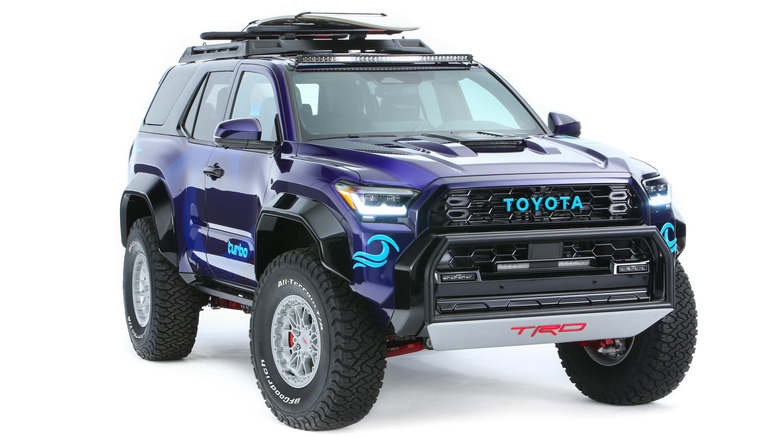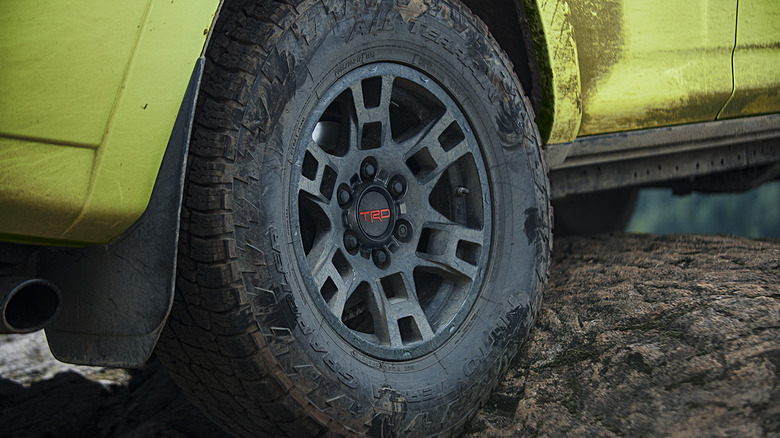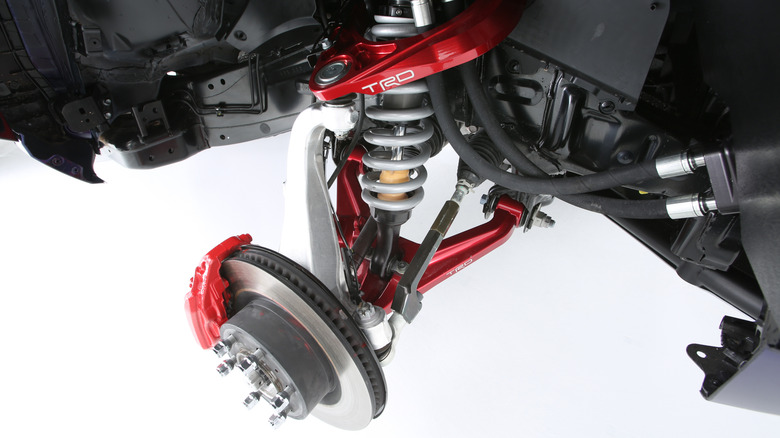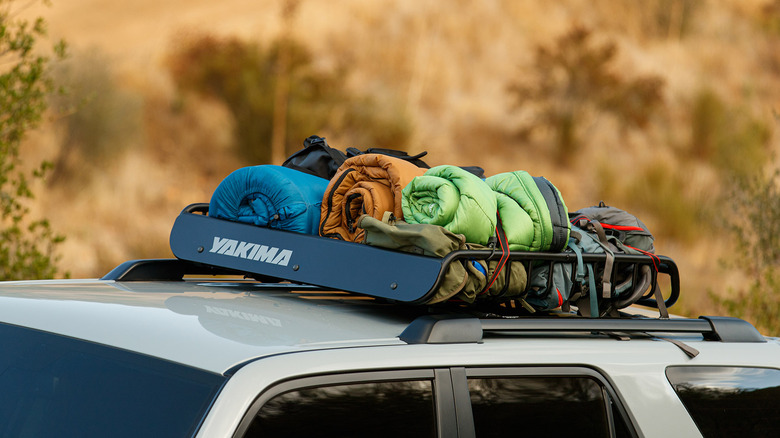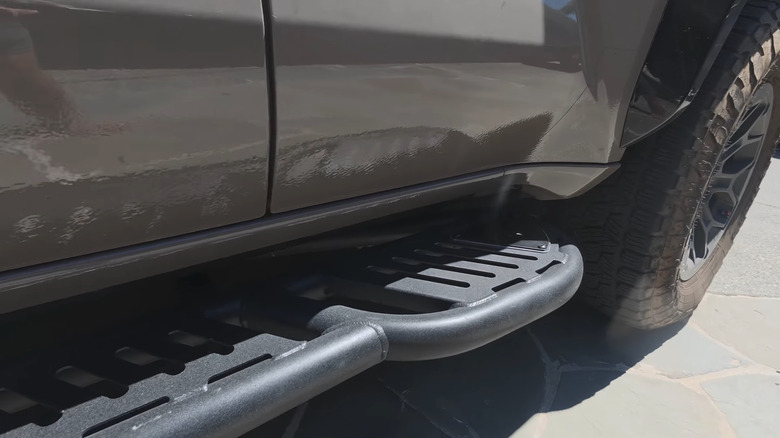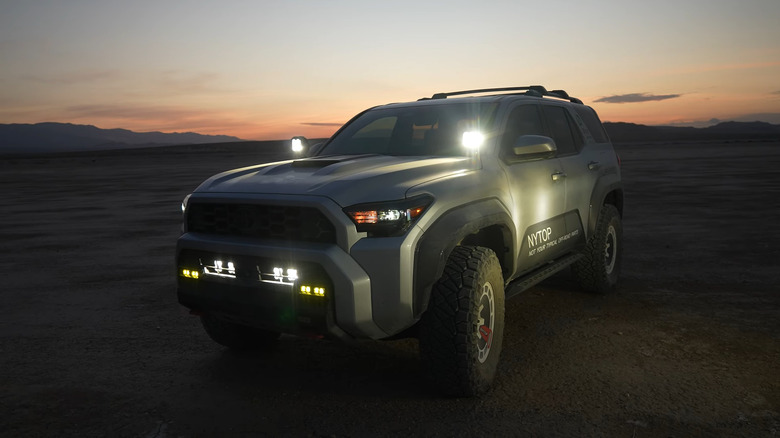5 Toyota 4Runner Mods That Will Take Your SUV To The Next Level
We may receive a commission on purchases made from links.
Few SUVs have a following like the one that the 4Runner enjoys. Hardly surprising, as since the first model launched in 1984, Toyota's rugged SUV offered a unique combination of the brand's legendary reliability with real off-road chops.
Of course, Toyota softened the 4Runner over the years to reach a wider audience. There is no V6 option anymore, either. In its place, Toyota installed a 2.4-liter turbocharged four-cylinder, available in regular and hybrid form. Still, the brand-new, 2025 Toyota 4Runner Trailhunter shows that the SUV is still a serious off-roader, with significant upgrades installed from the factory. The existence of other off-road trims, like the TRD Off-Road and TRD Pro, further proves that point.
Fortunately, you can do the same on older 4Runners — or cheaper trims — and get the same, or even better results. These upgrades won't only improve the off-road performance but give your 4Runner the rugged look it deserves. Crucially, you can make your 4Runner look and run the way you want — not how Toyota engineers imagined. Excited yet? Here are five mods that will take your 4Runner to the next level.
Off-Road-Capable Tires and Wheels
The easiest upgrade to improve your 4Runner's off-road ability would be replacing the existing highway tires with a set of all-terrain tires. These offer much better traction over slippery terrain, thanks to the deeper grooves and larger knobs, which can cling onto dirt, rocks, and mud. All-terrain tires are also tougher, featuring reinforced sidewalls and higher puncture resistance than regular tires. There are some downsides too, of course. Even the best all-terrain tires are louder, less fuel-efficient, and less grippy on paved roads than highway tires, but they offer a decent middle ground overall.
Which brings us to the next upgrade — real, meaty, off-road tires. These would be a great upgrade to 4Runner TRD Pro owners, a trim that already comes with OE all-terrain tires. Off-road tires have an even more aggressive tread pattern with deeper and wider grooves, which translate into much better traction on challenging terrains, like mud and large rocks. These tires are even louder and generally less performative than all-terrain tires on the street, though.
When choosing a set of all-terrain or off-road tires, you might be tempted to go wider for even more traction. In that case, you need to look into new wheels with negative offset or less backspacing to prevent tire rubbing. Don't go overboard, though, because pushing the wheels too wide will cause strain on the suspension components. While you're at it, you might also want to look into specific wheels for fast-paced desert driving, rock-crawling, or mudding, depending on your driving needs.
Off-Road-Focused Suspension Upgrades
Much like with tires, you can mod the suspension of your 4Runner to achieve different outputs. Some simple upgrades, like lift kits, will give you more road clearance for uneven terrain. Others, like new shocks, springs, or coilovers, can alter the way your 4Runner handles various terrains. Some shocks are designed for fast-paced riding on dirt while others offer high wheel travel for overlanding scenarios. There is no better example of this than comparing the latest 4Runner TRD Pro and Trailhunter. The TRD Pro has adjustable FOX QS3 monotube shock absorbers, built for jumping over dunes. Meanwhile, the Trailhunter comes with Old Man Emu monotube shocks designed for slow-paced driving over rocky terrain.
Fortunately, even if you have a low-spec 4Runner or an older model, there is a plethora of aftermarket suspension upgrades available. Old Man Emu, Eibach, Bilstein, Fox, and OME all build aftermarket coilovers that provide suspension lift and other performance benefits, like higher wheel travel. Still, it's important to choose the right coilover for your specific needs. Progressive shocks, for example, cope better with rough terrain, though they can be adjusted for road use. Digressive shocks are better for on-road responsiveness at lower speeds but become softer as you go faster. Linear shocks try to find the perfect balance. If you are on a budget, a simple leveling kit will provide you with higher road clearance, while keeping the OE shocks. These won't improve performance; In fact, they can accelerate wear on other suspension components and make your 4Runner less stable on the road. However, they will let you drive over bigger obstacles.
Functional Roof Racks or Baskets
A 4Runner with some upgrades can bring you places few other vehicles can. However, going far into the wilderness also means bringing more gear. The 4Runner has a decent cargo capacity with five seats in place, but a miniscule one with all three rows in use. In that case, a roof rack with a cargo box would be a great addition, since it can make even a small car feel spacious.
Even if you have some space inside the car, you can use roof racks to carry items that would otherwise not fit. Bicycles, kayaks and canoes, camping gear, and anything that you can imagine, especially if you also use waterproof bags to cover all your gear. That said, there are a few different types of roof racks. For cargo boxes and longer items like kayaks, bicycles, and skis, you'll need roof rails and cross bars. However, if you need to transport assorted items, roof baskets are the way to go. This $489.99 full-size roof basket on Amazon fits the fifth-gen 4Runner and allows you to attach heavy, irregular items thanks to its 800-pound capacity. While you're at it, it's a good idea to add a cargo net to protect your gear from falling off.
Since the 4Runner, particularly a lifted one, is tall, you'll also need a ladder to load the roof rack. A good example is this fixed fifth-gen 4Runner ladder, which costs $269 and doesn't add bulk to the vehicle.
Underbody Protection
Driving on challenging terrain, particularly large, sharp rocks, can pose a significant risk to your 4Runner's underbody. After all, the 4Runner is a body-on-frame truck, meaning the chassis is below the body and exposed to the terrain. The ladder chassis is an integral part of any SUV, and damaging it can render it useless. The transmission, differential, oil pan, fuel tank, and various electric parts are all exposed and can be damaged from protruding rocks.
Thus, it's very important to protect your 4Runner's underbody before attempting to traverse uneven terrains. Some 4Runner models, like the TRD Pro and Trailhunter, already come with some protection from the factory, but you can do better. For instance, the TRD Pro comes with light-duty rock sliders, which aren't strong enough to protect the vehicle's ladder frame if you do rock-crawling. Functional rock sliders should be made from sturdy materials, preferably "Drawn over Mandrel" steel, to withstand more abuse. As their name suggests, rock sliders allow you to slide over rocks and serve as a protective barrier for the frame.
To protect the oil pan, gas tank, transmission, and differential, you'll also need to install skid plates. These come in different shapes and sizes. Some, like sump guards, protect only the oil pan. Other models are designed for full protection of every part from the engine to the gas tank. Of course, choosing between partial and full protection depends on your needs. As for materials, aluminum skid plates are light and offer decent protection, while steel is more resistant but adds weight.
Off-Road Lighting
Off-road lighting is another important mod for 4Runner owners that often go overlanding or camping and need to drive during the night. This is because car headlights are designed for road use. On average, headlights illuminate the area between 300 and 500 feet in front of the vehicle, which is too far away for off-road use. In other words, they won't illuminate the terrain in front of the vehicle, which can be dangerous when traversing challenging terrains.
Off-road lights are designed to tackle that issue, illuminating crucial areas around your 4Runner, allowing you to spot obstacles you otherwise couldn't see. Choosing the right setup can be a bit daunting at first, though. The most important thing to tackle is the beam pattern. Spotlights produce a narrower beam, which is great for distance lighting. Meanwhile, fog lights, like LED bars, spread the light evenly, and are great for illuminating nearby areas. Combining spot and fog lights will give you the best of both worlds. For even better results, you can also add ditch lights, illuminating the area next to the vehicle. Roof lights are also popular because they offer good beam spread but can cause windshield glare.
Most off-road lighting systems today feature LED bulbs, which provide high luminance with less energy consumption. They also come in different color temperatures, expressed in Kelvin. Generally, cooler color temperature LEDs, like those ranging from 4000K to 6000K, provide higher visual clarity and contrast. However, warm LEDS with 3000K or less are better for driving through fog, dust, and snow, while also reducing eye fatigue.
